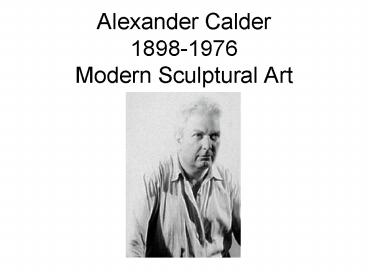Alexander Calder 18981976 Modern Sculptural Art - PowerPoint PPT Presentation
1 / 11
Title:
Alexander Calder 18981976 Modern Sculptural Art
Description:
After working in the field for a few years, he decided to become an artist. ... The original is in the Whitney Museum in New York City, though it occasionally ... – PowerPoint PPT presentation
Number of Views:162
Avg rating:3.0/5.0
Title: Alexander Calder 18981976 Modern Sculptural Art
1
Alexander Calder1898-1976Modern Sculptural Art
2
Childhood
- Alexander Calder was born in Pennsylvania 1898 to
a family of successful artists--his mother
painted and his father sculpted. - Calder began in early childhood to make wire and
cloth sculptures, sometimes as toys for his
sister. Here are shown two later wire sculptures
of his a fishbowl and a horse. - Worried about his ability to make a living as an
artist, he went to college, graduating with a
degree as a mechanical engineer. After working
in the field for a few years, he decided to
become an artist.
3
Cirque Calder
- Calder studied in New York and Paris. His most
successful early attempt was the creation of a
miniature circus, made out of wire, cloth, and
other found objects. - Look closely at these old photos of his circus.
What do you see? Do you see the animal on the
cart in the bottom photo? What about the
traveling cage in the top?
4
Cirque Calder
- These are more recent photos. The original is in
the Whitney Museum in New York City, though it
occasionally travels to other museums for
temporary exhibits. - In the top photo, what animals can you identify?
Do you see an acrobat? Can you name three
different materials he used? - In the bottom photo, what are the tumblers doing?
Does this look like a circus?
5
Variety of Media
- In Paris, Calder was exposed to artists like Piet
Mondrian (mo-dree-on), who were exploring
abstract art. Calder was attracted to the idea
of art with no reference to figurative reality
and began to use abstraction in his own work. - Calder could work in almost any medium. The top
grouping here are toys, while the bottom is a
necklace. He also did paintings, carpets, wall
hangings, as well as sculpture.
6
Kinetic Art
- Calder melded his interests and created the first
kinetic art, or what we would call mobiles.
Mobiles are art that moves, and Calder was a
master of it. He eventually created works that
required the merest breath of air to turn and
move. - His mobiles often create a secondary pattern by
the shadows thrown by the sculpture.
7
Kinetic Art
- Calder mobiles combine strength and delicacy.
Although many of his works are abstract, there is
often a hint of whimsy. What do you see in this
work? A seal? A coat-hanger?
8
National Gallery of Art
- Both of these works are in Washington, DC.
- Calder could work in almost any scale--from the
tiny Cirque Calder to these very large works. - The top work is a colorful work in an outdoor
garden. - The bottom huge work takes up a large interior
space inside the Museums modern wing. - Notice the importance of shadow to his work. He
also tried to stay with simple strong colors.
9
Large Scale Sculpture
- This large outdoor work is in Hanover, Germany.
What do you think its of? - Notice how small the cars are in comparison to
the work. How do you think he made something
this large? - He actually made a small exact model and then had
metal workers help to cast the final large-scale
piece.
10
Large Scale Sculpture
- The name of this work is Red Horse. Its in
Washington, DC. - Do you see a horse? Why do you think he didnt
put on the heads? Does this horse remind you of
the wire horse sculpture that was on the first
slide? - His popularity means you can find his works in
most major cities and virtually all major
collections.
11
Large Scale Sculpture
- This work is in Grenoble, France. What do you
think it represents? - Calder was successful during his lifetime. He
was honored in United States and sold his works
throughout the world. Many art museums have his
works in their collections, including Houston and
Dallas. - When you have a chance to see his work, make
certain you walk all the way around it. The
changes in perspective fascinated him.































